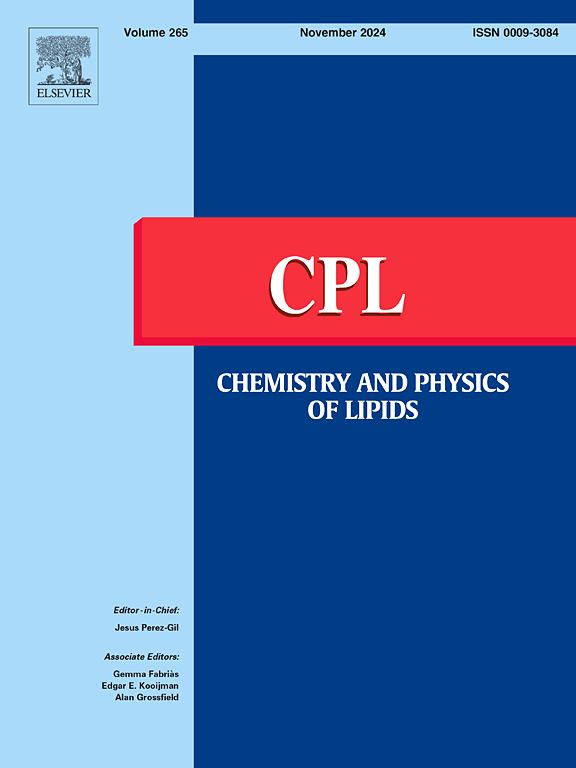Different propensity to oxidation and responses to compression of unsaturated mono- and di-galactosyldiacylglycerol Langmuir monolayers: Possible role of polymorphic transitions in lipid phase in the context of energy-converting membranes
IF 2.8
3区 生物学
Q2 BIOCHEMISTRY & MOLECULAR BIOLOGY
引用次数: 0
Abstract
Monogalactosyldiacylglycerol (MGDG) and digalactosyldiacylglycerol (DGDG) are the main lipids present in thylakoids, site of photosynthesis in chloroplasts. In this work we are interested in the behavior of highly unsaturated MGDG and DGDG, studied by surface pressure measurements. Compression isotherms of these lipids show that they are able to form Langmuir monolayers, remaining in liquid expanded phase during all the compression. However, measurements at constant surface pressure and compression modulus suggest that these monolayers are not stable, even if increasing the number of spread molecules seems to increase the stability, with a particularly noticeable effect in the case of MGDG as compared to DGDG. Monolayers are then transferred on mica supports and resulting Langmuir-Blodgett films are imaged by Atomic Force Microscopy. Images and height profiles reveal the presence of thicker areas showing that some molecules are ejected outside the monolayer’s plane, with a higher propensity in the case of MGDG monolayers. We discuss these results taking into account two mechanisms, which may occur jointly: the oxidation of lipid hydrophobic chains and the desorption of lipids from the interface. The desorption amplitude would be higher in the case of MGDG, due to its propensity to organize in non-bilayer nature.
不同的氧化倾向和对不饱和单和双半乳糖二酰基甘油朗缪尔单分子层的压缩反应:在能量转换膜的背景下,脂相中多态转变的可能作用。
单半乳糖基二酰基甘油(MGDG)和双半乳糖基二酰基甘油(DGDG)是叶绿体中主要存在于类囊体中的脂类。在这项工作中,我们对高度不饱和的MGDG和DGDG的行为感兴趣,通过表面压力测量研究。这些脂质的压缩等温线表明它们能够形成朗缪尔单分子层,并在所有压缩过程中保持液体膨胀相。然而,在恒定的表面压力和压缩模量下的测量表明,即使增加扩散分子的数量似乎可以增加稳定性,这些单层也不稳定,与DGDG相比,MGDG的效果尤其明显。然后将单层膜转移到云母支架上,得到的Langmuir-Blodgett薄膜通过原子力显微镜成像。图像和高度分布图显示了较厚区域的存在,表明一些分子被喷射到单层的平面外,在MGDG单层的情况下有更高的倾向。我们在讨论这些结果时考虑了两种可能共同发生的机制:脂质疏水链的氧化和脂质从界面上的解吸。在MGDG的情况下,由于其倾向于以非双层性质组织,解吸幅度会更高。
本文章由计算机程序翻译,如有差异,请以英文原文为准。
求助全文
约1分钟内获得全文
求助全文
来源期刊

Chemistry and Physics of Lipids
生物-生化与分子生物学
CiteScore
7.60
自引率
2.90%
发文量
50
审稿时长
40 days
期刊介绍:
Chemistry and Physics of Lipids publishes research papers and review articles on chemical and physical aspects of lipids with primary emphasis on the relationship of these properties to biological functions and to biomedical applications.
Accordingly, the journal covers: advances in synthetic and analytical lipid methodology; mass-spectrometry of lipids; chemical and physical characterisation of isolated structures; thermodynamics, phase behaviour, topology and dynamics of lipid assemblies; physicochemical studies into lipid-lipid and lipid-protein interactions in lipoproteins and in natural and model membranes; movement of lipids within, across and between membranes; intracellular lipid transfer; structure-function relationships and the nature of lipid-derived second messengers; chemical, physical and functional alterations of lipids induced by free radicals; enzymatic and non-enzymatic mechanisms of lipid peroxidation in cells, tissues, biofluids; oxidative lipidomics; and the role of lipids in the regulation of membrane-dependent biological processes.
 求助内容:
求助内容: 应助结果提醒方式:
应助结果提醒方式:


